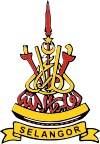Selangor
| Selangor سلاڠور |
|||
|---|---|---|---|
| — State — | |||
| Selangor Darul Ehsan | |||
|
|||
| Motto: Dipelihara Allah | |||
| Anthem: Duli Yang Maha Mulia | |||
 |
|||
| Coordinates: | |||
| Capital | Shah Alam | ||
| Royal capital | Klang | ||
| Government | |||
| - Ruling party | Pakatan Rakyat | ||
| - Sultan | Sultan Sharafuddin Idris | ||
| - Menteri Besar | Tan Sri Abdul Khalid Ibrahim | ||
| Area | |||
| - Total | 7,956 km2 (3,071.8 sq mi) | ||
| Population (2009 est.) | |||
| - Total | 5,180,000 | ||
| - Density | 651.1/km2 (1,686.3/sq mi) | ||
| Human Development Index | |||
| - HDI (2008) | 0.907 (very high) | ||
| Postal code | 40xxx to 48xxx 62xxx to 64xxx |
||
| Calling code | 03 | ||
| Vehicle registration | B | ||
| Federated into FMS | 1895 | ||
| Japanese occupation | 1942 | ||
| Accession into Federation of Malaya | 1948 | ||
| Website | http://www.selangor.gov.my | ||
Selangor (Jawi script: سلاڠور; also known by its Arabic honorific, Darul Ehsan, or "Abode of Sincerity") is one of the 13 states of Malaysia. It is on the west coast of Peninsular Malaysia and is bordered by Perak to the north, Pahang to the east, Negeri Sembilan to the south and the Strait of Malacca to the west. It completely surrounds the federal territories of Kuala Lumpur and Putrajaya, both of which were once under Selangor's sovereignty.
The state is a hereditary constitutional monarchy, of which the reigning Sultan (since 2001) is Sultan Sharafuddin Idris Shah. Since March 10, 2008, the Menteri Besar (chief executive of the state government) has been Tan Sri Abdul Khalid Ibrahim, of the People's Justice Party (PKR) portion of Pakatan Rakyat. The current leader of the opposition in the Selangor State Assembly is Dato' Seri Dr. Mohamed Khir Toyo, who is part of the United Malays National Organisation (UMNO) party within the Barisan Nasional coalition. He was also the 13th Menteri Besar of Selangor.
The state capital is Shah Alam, the first city in Selangor, and the royal capital is Klang. Another major urban centre is Petaling Jaya which was awarded city status on June 20, 2006. Selangor is one of only two Malaysian states with more than one city; the other is Sarawak.
Contents |
Etymology
The origin of the name Selangor is lost in history, although some sources claim the name to have come from the Malay word selangau, 'a large fly', most probably due to the abundance of flies in the marshes along the Selangor River in the state's northwest. A more plausible theory claims the state's name is derived from the term Selang Ur meaning "land of the straits" (selang means "straits" in the Malay language and ur means "town" in Tamil.) Aur (which sounds similar to ur) also means river in Malay. Hence, Selangor may mean 'river straits'. Another possible origin of the name is from combination of the words Sela and Ngor (sela means 'a gap' and ngor means 'bamboo'). It may be possible that the banks of the Selangor River was full of bamboo groves in the distant past. However bamboo do not grow well in the marshy soil of the lower reaches of the river. It is also possible that the word Selangor is an Orang Asli term as some rivers have Orang Asli names, e.g. Damansara river.
Available written records such as the Malay Annals refers to Selangor as Samarlingga during the rule of Seri Paduka Maharaja in Singapore (1301-1400) whereas some Chinese maps from the Ming Dynasty used by the Admiral Zheng He during his voyages of expedition between 1405 to 1433 refers to the Klang River and Selangor Darat (or inland Selangor) [1].
History
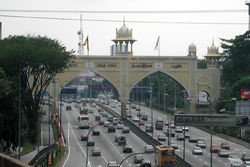
In the 15th century, Selangor was ruled by the Sultanate of Malacca. After the fall of Malacca to the Portuguese in 1511, the area became hotly disputed between the Portuguese, Johor, Aceh and Siam. When the Dutch displaced the Portuguese from Malacca in 1641, they brought in Muslim Bugis mercenaries from Sulawesi. They established the present hereditary sultanate in 1740. In many districts, Bugis settlers displaced the Minangkabau settlers from Sumatra, who had established themselves in Selangor some 100 years previously.
In the 19th century, the economy boomed due to the exploitation of huge tin reserves and the growing importance of rubber. This attracted a large influx of Chinese migrant laborers. Chinese secret clan societies, allied with Selangor chiefs, fought for control of the tin mines. The increasing violence created social and economic havoc. It also opened a window of opportunity for the British government, which forced the Sultan of Selangor to accept a British Resident in 1874. Under the stability imposed by the British, Selangor again prospered. In 1896, largely through the coordination of the Resident, Frank Swettenham, Selangor united with Negri Sembilan, Perak and Pahang to form the Federated Malay States, with its capital in Kuala Lumpur.
The Federated Malay States evolved into the Federation of Malaya in 1948, which became independent in 1957, and Malaysia in 1963. The city of Kuala Lumpur functioned as both the national capital of Malaysia and the state capital of Selangor. In 1974, Selangor relinquished Kuala Lumpur to the federal government. The state capital was moved to Shah Alam after the cession.
Putrajaya, a new city designed to be the new administrative capital of Malaysia, was built by the federal government in Selangor. The Sultan of Selangor, Sultan Salahuddin, was asked again to cede land to the federal government. Putrajaya became a federal territory in 2001.
Selangor is currently the richest, most industrialized and most urbanized of all Malaysian states. As Menteri Besar, Mohamed Khir Toyo declared Selangor a developed state on 27 August 2005.
Population and demographics
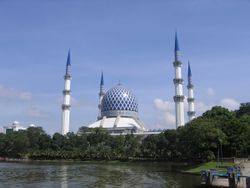
Selangor is Malaysia's most populous state with the nation's biggest conurbation, the Klang Valley. Selangor's geographical position in the centre of Peninsular Malaysia contributed to the state's rapid development as Malaysia's transportation and industrial hub. This created jobs and attracted migrants from other states as well as overseas, especially from Indonesia, the Philippines, Vietnam, Myanmar, Bangladesh, India, Pakistan, and China. In recent decades, the influx of illegal immigrants, particularly from Indonesia, has further contributed to Selangor's population.
| Rank | Districts | Population 2009 |
|---|---|---|
| 1 | Petaling | 1,547,100 |
| 2 | Hulu Langat | 1,170,900 |
| 3 | Klang | 840,700 |
| 4 | Gombak | 688,700 |
| 5 | Kuala Langat | 244,100 |
| 6 | Kuala Selangor | 201,600 |
| 7 | Hulu Selangor | 198,000 |
| 8 | Sepang | 150,500 |
| 9 | Sabak Bernam | 138,00 |
Selangor has a population of around 5 million (2008 estimate; the state's ethnic composition consisted of Malaysian 52.9%, Chinese Malaysia 27.8%, Indian Malaysians 13.3%, and other ethnic groups 6%.[2] The ten most populated cities in Selangor as of 2009 are:
| Rank | City | Population 2009 |
|---|---|---|
| 1 | Subang Jaya | 1,321,672 |
| 2 | Klang | 1,055,207 |
| 3 | Ampang Jaya | 756,309 |
| 4 | Shah Alam | 617,149 |
| 5 | Petaling Jaya | 543,410 |
| 6 | Cheras | 515,961 |
| 7 | Kajang | 428,131 |
| 8 | Selayang Baru | 253,921 |
| 9 | Rawang | 178,500 |
| 10 | Taman Greenwood | 146,057 |
The traditional culture of Selangor's Malay majority is influenced by those of Bugis, Johor, Minangkabau, Mandailing and Javanese ancestry, most of whom are Muslim. Javanese ancestry were dominant in west coast district such as Sabak Bernam, Kuala Selangor, Klang, Kuala Langat and Sepang. Selangor's population also has ethnic Chinese and Indian influences; those two groups have the larger minority populations. With its state of development, Selangor is more closely tied to the Western world through trade, business and education than other, more rural states..
Politics
Constitution
The Constitution of the State of Selangor came into force on the 26 of February 1959. The constitution is separated into two parts. Under the 1959 constitution, Selangor is a constitutional monarchy.
Selangor Sultanate
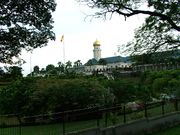
The Sultan of Selangor is the constitutional Ruler of Selangor. The role, powers and duties of the Sultan are set forth in the constitution of 1959. The constitution proclaims that the office of Sultan is vested with the executive power of the state, is the head of the religion of Islam in the state and the "fountain of honours and dignities" in the state.
This position is hereditary and can only be held by a member of Selangor's royal family. The current ruler is His Royal Highness Sultan Sharafuddin Idris Shah, who has held this position since 2001.
State Executive Council
The State Executive Council, which along with the Sultan is Selangor's executive branch of government, was established by the constitution of 1959. It is composed of the Menteri Besar, who is its chairman and Selangor's head of government, and ten other members. The Menteri Besar and other members of the council are appointed by the Sultan of Selangor from members of the State Assembly. The current Menteri Besar is Tan Sri Abdul Khalid Ibrahim, of the Parti Keadilan Rakyat (PKR, or People's Justice Party) who succeeded UMNO's Menteri Besar, Datuk Seri Dr. Khir Toyo.
State Assembly
The state also has a legislative branch, called the Selangor State Assembly. It is similar to the Parliament but is limited to making laws relating to the state. Its members are elected in elections which are usually held simultaneously with federal elections. The term of each state assembly member is limited to five years. The state assembly must be dissolved before or once it expires its term for a fresh election to elect its members.
State Government Agencies
|
|
Administration
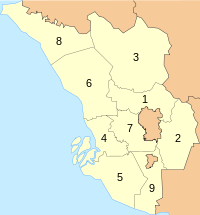
List of districts
Selangor is divided into 9 administrative districts.
- Gombak
- Hulu Langat
- Hulu Selangor
- Klang, along with Port Klang (formerly known as Port Swettenham)
- Kuala Langat
- Kuala Selangor
- Petaling, contains the Sultan Abdul Aziz Shah Airport (formerly Subang International Airport)
- Sabak Bernam
- Sepang, contains the Kuala Lumpur International Airport
List of local authorities
There are 12 local authorities in Selangor, namely:
- Majlis Bandaraya Petaling Jaya (MBPJ)
- Majlis Bandaraya Shah Alam (MBSA)
- Majlis Daerah Hulu Selangor (MDHS)
- Majlis Daerah Kuala Langat (MDKL)
- Majlis Daerah Kuala Selangor (MDKS)
- Majlis Daerah Sabak Bernam (MDSB)
- Majlis Perbandaran Ampang Jaya (MPAJ)
- Majlis Perbandaran Kajang (MPKj)
- Majlis Perbandaran Klang (MPK)
- Majlis Perbandaran Selayang (MPS)
- Majlis Perbandaran Sepang (MPSepang)
- Majlis Perbandaran Subang Jaya (MPSJ)
Economy
The economy of Selangor is constituted by a progressive market economy. The core sectors of Selangor's economy are commerce and agriculture.
Selangor is the richest state in the country in terms of gross domestic product (GDP) per capita (PPP), which stood at USD 33,147 in 2008, comparable to the nominal per capita values of Western Europe and Hong Kong.[3]. On 27 August 2005, Selangor was officially declared the first developed state in Malaysia by the then state government[4]. In 2008, the state recorded a Human Development Index of 0.907 - a figure comparable to modern advanced economies such as Germany, the United Kingdom and South Korea.
Commerce, industry and services
Commerce, industry and services are a major contributor to the economy of Selangor, as it accounted for over 58% of the state's GDP in 2008. It has several industrial sites that produce electronic goods, chemicals and automotive vehicles, such as Proton and Perodua cars. Imported vehicles are also assembled in the state.
Many international factories that are represented in the country have set up their bases here. Among the industrial cities in Selangor are Subang Jaya, Shah Alam, Klang, Kajang, Rawang, Selayang, Ampang Jaya and Petaling Jaya. Port Klang plays a key factor in the industrial development of Selangor as it is the busiest port in Malaysia. Selangor attracts foreign investors as well.
The services sector is the second largest contributor to GDP of 38% of the state.
Agriculture
Alongside industries, agriculture is a thriving sector of Selangor's economy. In 2008, agriculture contributed to 3.1% of the state's GDP at that time. Selangor is a significant state involved in the cultivation and growth of star fruits, papayas and bananas. While the state is not a major producer of rice, the paddy fields in Kuala Selangor contribute to the development of the district. Other agricultural activities that are conducted in Selangor include the establishment of palm oil and rubber plantation sites.
Tourism
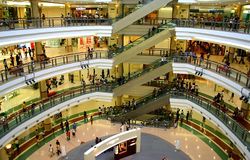
Tourism is still not an important aspect of Selangor's economy, but the state is gaining recognition as a number of tourist attractions within Selangor are increasing in popularity, like the Sepang International Circuit, Sunway Lagoon in Bandar Sunway and the Firefly Park in Kuala Selangor.
The larger towns and cities in Selangor consist of various shopping malls that are frequented by tourists and locals, such as 1 Utama in Bandar Utama; The Curve, e@Curve (formerly known as Cineleisure Damansara), Ikano Power Centre and IKEA in Mutiara Damansara; Tropicana City Mall in Damansara Utama; Sunway Pyramid in Bandar Sunway; Mines Wonderland in Seri Kembangan; Subang Parade, Empire Shopping Gallery and Summit USJ in Subang Jaya; IOI Mall in Puchong; ÆON Bukit Tinggi Shopping Centre and Bukit Raja Shopping Centre in Klang; Plaza Alam Sentral and SACC Mall in Shah Alam.
Transportation

Selangor is linked to the rest of Malaysia by comprehensive air, road and rail connections. Public transportation is represented in Selangor, although it is underutilised, as is the case in Kuala Lumpur. Most of the major highways that run through the West Coast of the peninsula, including the North-South Expressway, serve Selangor as well. The high speed roadways, or expressways are tolled roadways, and motorists using these expressways have an option of paying by cash, or by stored value cards such as Touch 'n Go and SmartTAG.
Kuala Lumpur International Airport, the country's primary airport, is located in the peripheral district of Sepang in Selangor near the state's border with Negeri Sembilan. The Kuala Lumpur International Airport consists of the main terminal and the Low Cost Carrier Terminal (LCCT). Selangor also has a domestic airport, that is the Sultan Abdul Aziz Shah Airport.
Port Klang, which is the busiest gateway into Malaysia by sea, is located at the western tip of Selangor.
The KTM Komuter railway network services many outlying districts and nearby towns such as Kajang, Port Klang, Shah Alam, Subang Jaya, Rawang and many more. It is also linked to other rail transit services at the KL Sentral Station, a modern transportation hub in the city centre. Selangor is accessible by the Rapid KL Ampang Line and Kelana Jaya Line Light Rail Transit (LRT) services.
Extensions LRT Project
On 29 August 2006, Malaysian Deputy Prime Minister Mohd Najib Abdul Razak announced that the western end of the Kelana Jaya Line would be extended to the suburbs of Bandar Sunway, Subang Jaya and UEP Subang Jaya (USJ), which are located to the south-west of Kuala Lumpur. The extension will be part of a RM10 billion plan to expand Kuala Lumpur's public transport network.
The expansion plan will also see the Ampang Line extended to the suburb of Puchong and the south-west of Kuala Lumpur The plan also involved the construction of an entirely new line, tentatively called the Kota Damansara-Cheras Line, running from Kota Damansara in the western portion of the city, to Cheras which lies to the south-east of Kuala Lumpur.
In September 2009, Syarikat Prasarana Negara began a public viewing for the details of the alignment for the Ampang Line and Kelana Jaya Line at various locations. The public are able to provide feedback based on the route during the 3 months display period. The extension will see the Kelana Jaya Line and Ampang Line adding 13 new stations and 17.7 km of new track to its network. The new terminus will be at Putra Heights where the line will meet the Kelana Jaya Line and Ampang Line to provide a suburban interchange. Construction is expected to begin in early-2010 once the public feedback period is closed and completion due for 2012.
Education
Selangor has plenty of tertiary level education choices. The majority of these academic centres are conveniently located in the heart of major towns and cities.
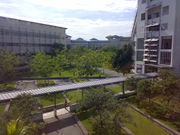
Public universities
| Name | Acronym | Foundation | Location |
|---|---|---|---|
| International Islamic University of Malaysia | IIUM | 1983 | Gombak |
| Universiti Teknologi MARA | UiTM | 1999 | Shah Alam |
| Universiti Kebangsaan Malaysia | UKM | 1970 | Bangi |
| Universiti Putra Malaysia | UPM | 1971 | Serdang |
Private universities and university colleges
International universities campus in Selangor
| Name | Acronym | Foundation | Location | |
|---|---|---|---|---|
| Al-Madinah International University | MEDIU | 2006 | Shah Alam | |
| Binary University College of Management and Entrepreneurship | BUCME | 1984 | Puchong | |
| Cyberjaya University College of Medical Sciences | CUCMS | 2005 | Cyberjaya | |
| Industrial University of Selangor | UNISEL | 1999 | Bestari Jaya | |
| International Universiti College Of Nursing | - | - | Petaling Jaya | |
| International Universiti College Of Technology Twintech | TWINTECH | - | Bangi | |
| Kuala Lumpur Infrastructure University College | KLIUC | 1973 | Kajang | |
| Limkokwing University of Creative Technology | LUCT | 1992 | Cyberjaya | |
| Malaysia University of Science and Technology | MUST | 2000 | Petaling Jaya | |
| Management and Science University | MSU | 2002 | Shah Alam | |
| Masterskill University College of Health Sciences | MASTERSKILL | 1997 | Cheras | |
| Multimedia University | MMU | 1994 | Cyberjaya | |
| SEGi university college | SEGi | 1977 | Kota Damansara | |
| Selangor International Islamic University College | KUIS | 1995 | Bangi | |
| Sunway University College | SYUC | 1987 | Subang Jaya | |
| Taylor's University College | TAYLOR | 1969 | Subang Jaya | |
| Tenaga Nasional University | UNITEN | 1976 | Kajang | |
| Tun Abdul Razak University | UNITAR | 1998 | Petaling Jaya | |
| Name | Acronym | Foundation | Location | From |
| Monash University | Monash | 1998 | Subang Jaya | Australia |
| University of Nottingham | UNiM | 2000 | Semenyih | United Kingdom |
Healthcare
Hospitals in Selangor are listed below:
|
Public Hospitals
|
Private Hospitals
|
Cuisine
The traditional Malay cuisine in Selangor has received influences from Johor, Bugis, Jawa and Minangkabau.
Rojak Klang, Lontong Klang and Mee Bandung Muar are famous cuisines in Klang and Shah Alam (Note: Mee Bandung is also touted to have originated from Johor). Other famous dishes include Mee Jawa (which is similar to Mee Rebus in Johor), Satay Kajang, Laksa Selangor, Soto (Soto Nasi Himpit and Mee Soto), Sambal Tahun, Bakso, Ketam Darul Ehsan, Ikan Masak Asam Pedas, Ayam Masak Kicap and Sayur Masak Rebung.
Klang bak kut teh is famous among the Chinese population. It is a herbal pork soup which is eaten with white rice. Coastal towns such as Klang and Kuala Selangor are also famed for seafood.
Media
Television

Selangor have seven broadcast television stations:
- Radio Televisyen Malaysia (RTM). Federal government owned media company with 3 channels (free-to-air).
- TV1
- TV2
- Muzik Aktif
- TV3 (Sistem Televisyen Malaysia Berhad) of Media Prima Berhad. (free-to-air)
- ntv7 (Natseven TV Sdn.Bhd) of Media Prima Berhad. (free-to-air)
- 8TV (Metropolitan TV Sdn.Bhd) of Media Prima Berhad. (free-to-air)
- TV9 (Ch-9 Media Sdn.Bhd) of Media Prima Berhad. (free-to-air)
- Astro (All Astro Plc). Digital satellite tv with more than 100 channels. (pay tv)
- TVSelangor (Selangor state government owned station). This channel only available on internet via www.tvselangor.com
- ANN (Alternative News Network). This channel only available on internet via www.ann.com.my
- TV Al-Hijrah (Al-Hijrah Media Corporation Berhad) owned by Malaysian Government. This new free-to-air television channel in Malaysia is expected to be launch by mid year of 2010 and focusing in Islamic contents.
Internet TV
Radio
Radio station in Selangor are available in FM frequency.
Commercial radio stations available in Selangor include Era (103.3), Sinar FM (96.7), XFM (103.0), Hot FM (97.6), Suria FM (105.3), Best104 (104.1), Hitz.fm (92.9), Mix FM (94.5), Lite FM (105.7), Red FM (104.9), Fly FM (95.8), BFM (89.9), Capital FM (88.9), 988 (98.8), My FM (101.8), One FM (88.1) and THR (99.3). Commercial radio stations is operates by a few media companies such as AMP Radio Networks Sdn.Bhd, Star RFM Sdn.Bhd, Media Prima Berhad, Suara Johor Sdn.Bhd and BFM Media. Local community radio stations include UFM (93.6) operates by Universiti Teknologi MARA (only available in Shah Alam-Klang-Petaling Jaya area), and Putra FM (90.7) operates by Universiti Putra Malaysia (only available in Serdang-Seri Kembangan area) which targets the university students. The nine Radio Televisyen Malaysia (RTM) radio networks available are Klasik Nasional (98.3), Muzik FM (95.3), Ai FM (106.7), Traxx FM (100.1), Minnal FM (96.3), Asyik FM (91.1), Selangor FM (100.9), KLFM (97.2) and Pahang FM (107.5). Another three speciality radio stations are IKIM.fm (91.5) operate by IKIM, Salam FM (91.1) operate by JAKIM, and Radio24 (93.9) operate by BERNAMA. Selangor border areas can also receive another two Radio Televisyen Malaysia (RTM) radio station; Perak FM (Selangor-Perak border) and Negeri FM (Selangor-Negeri Sembilan border).
Newspaper

Mainstream newspapers in Selangor are:
- Berita Harian (in Bahasa Malaysia)
- Utusan Malaysia (in Bahasa Malaysia)
- Kosmo! (in Bahasa Malaysia)
- Harian Metro (in Bahasa Malaysia)
- Sinar Harian (in Bahasa Malaysia)
- Selangor Kini (in Bahasa Malaysia)
- New Straits Times (in English)
- The Star (in English)
- The Malay Mail (in English)
- The Sun (in English)
- Nanyang Siang Pau (in Mandarin)
- Sin Chew Jit Poh (in Mandarin)
- China Press (in Mandarin)
- Malaysia Nanban (in Tamil)
- Tamil Nesan (in Tamil)
- Makkal Osai (in Tamil)
- Harakah (in Bahasa Malaysia and English). Malaysia opposition leading newspaper. Operates by PAS (Pan-Malaysian Islamic Party). Only available two times a week.
Image gallery
 Batu Caves |
 Silver Leaf Monkey in Bukit Melawati |
 Royal Selangor Pewter |
 Commonwealth Forest Park |
 Kanching Rainforest Waterfall |
 Pasar Borong Selayang |
 Pulau Ketam |
 Forest Research Institute of Malaysia (FRIM) |
References
- ↑ Kuala Selangor District Council: Latar Belakang Kuala Selangor (Malay) (URL last accessed June 7 2010)
- ↑ SSIC - from YB Dato' Tang See Hang - Selangor State Executive Councillor.
- ↑ "Selangor Maju Criteria". Bernama. http://www.bernama.com/selangor_maju/sm_criteria.php?lang=en. Retrieved 2009-06-10.
- ↑ "Najib: Selangor's Development Due To Leadership And Cooperation". Bernama. August 26, 2005. http://www.bernama.com/bernama/v3/printable.php?id=152346. Retrieved 2009-06-09.
External links
- Official website
- Selangor travel guide from Wikitravel
- Rail map of Selangor
- Geographical maps of Selangor
- History of Selangor
|
|||||||||||||||||||||||
|
||||||||
 |
 |
|||
| Strait of Malacca | ||||

